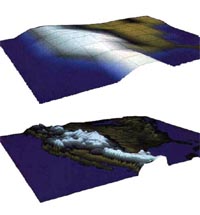
Examples of two different computer models and their corresponding resolution. The top picture represents North America with a grid size of 480 km, typical of most climate models. The bottom picture is a higher resolution with a grid size of 60 km, typical of weather forecasting models. Note how much topographic detail is lost in the low resolution model; the loss of detail about ocean-atmosphere interaction is of an equal scale. (From: CO2 Science Magazine)
